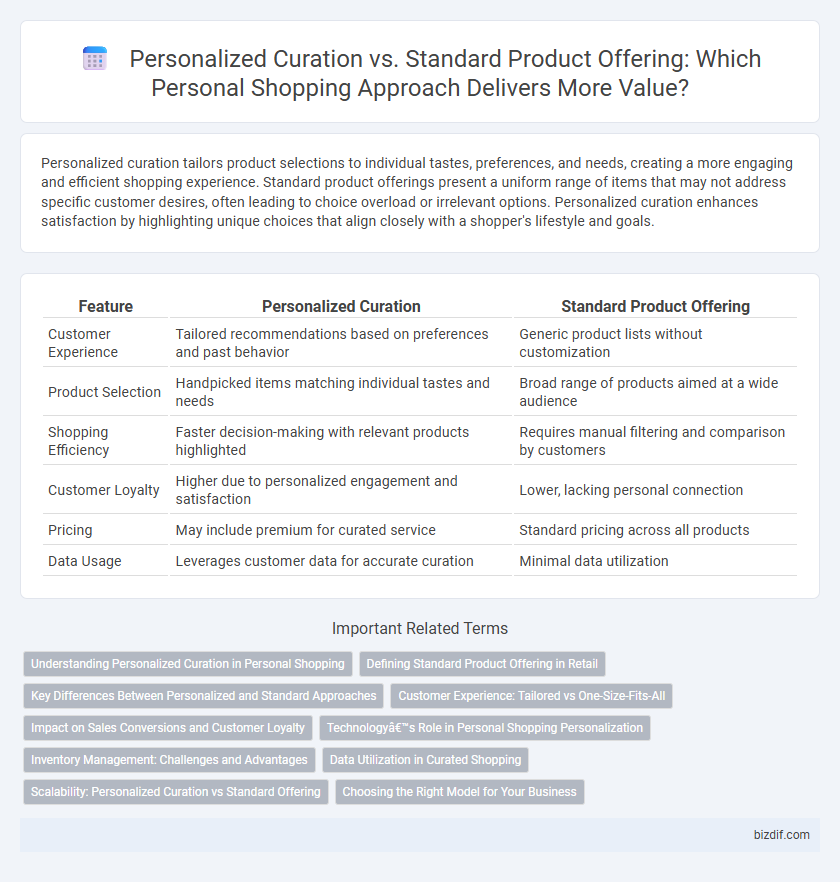Personalized curation tailors product selections to individual tastes, preferences, and needs, creating a more engaging and efficient shopping experience. Standard product offerings present a uniform range of items that may not address specific customer desires, often leading to choice overload or irrelevant options. Personalized curation enhances satisfaction by highlighting unique choices that align closely with a shopper's lifestyle and goals.
Table of Comparison
| Feature | Personalized Curation | Standard Product Offering |
|---|---|---|
| Customer Experience | Tailored recommendations based on preferences and past behavior | Generic product lists without customization |
| Product Selection | Handpicked items matching individual tastes and needs | Broad range of products aimed at a wide audience |
| Shopping Efficiency | Faster decision-making with relevant products highlighted | Requires manual filtering and comparison by customers |
| Customer Loyalty | Higher due to personalized engagement and satisfaction | Lower, lacking personal connection |
| Pricing | May include premium for curated service | Standard pricing across all products |
| Data Usage | Leverages customer data for accurate curation | Minimal data utilization |
Understanding Personalized Curation in Personal Shopping
Personalized curation in personal shopping leverages customer data, preferences, and lifestyle insights to tailor product selections uniquely suited to the individual. Advanced algorithms and expert styling converge to enhance shopping efficiency and satisfaction by delivering relevant, exclusive choices beyond standard product offerings. This approach increases customer engagement, loyalty, and conversion rates through a highly customized retail experience.
Defining Standard Product Offering in Retail
Standard product offering in retail refers to a fixed assortment of goods available to all customers without customization, designed to meet broad market demands. This approach emphasizes consistency, inventory efficiency, and predictable sales patterns by providing commonly preferred products across various demographics. Retailers relying on standard offerings prioritize streamlined stocking and straightforward purchasing experiences over individual preferences.
Key Differences Between Personalized and Standard Approaches
Personalized curation utilizes data-driven insights, such as individual preferences, purchase history, and real-time behavior, to tailor product selections uniquely for each customer, whereas standard product offerings present a uniform inventory to all shoppers. This customized approach enhances customer engagement and satisfaction by delivering relevant recommendations, contrasting with the broader appeal strategy of standard offerings that may result in missed personalization opportunities. Personalized curation leverages advanced algorithms and artificial intelligence to dynamically adapt the shopping experience, optimizing conversion rates and brand loyalty beyond the capabilities of traditional product displays.
Customer Experience: Tailored vs One-Size-Fits-All
Personalized curation enhances customer experience by delivering product recommendations based on individual preferences, purchase history, and unique style, fostering higher satisfaction and loyalty. Standard product offerings provide a one-size-fits-all selection that may overlook specific customer needs, leading to less engagement and a generic shopping journey. Tailored experiences through data-driven personalization drive increased conversion rates and stronger brand connections compared to uniform product assortments.
Impact on Sales Conversions and Customer Loyalty
Personalized curation significantly boosts sales conversions by tailoring product selections to individual preferences, leading to higher customer satisfaction and repeat purchases. Standard product offerings often result in lower engagement as they fail to address diverse customer needs, limiting brand loyalty. Data-driven personalization enhances customer retention by creating a unique shopping experience that fosters trust and long-term relationships.
Technology’s Role in Personal Shopping Personalization
Technology revolutionizes personal shopping by enabling personalized curation through data-driven algorithms that analyze consumer preferences, purchase history, and browsing behavior to recommend tailored products. Artificial intelligence and machine learning enhance product discovery beyond standard offerings by predicting trends and customizing selections in real-time. Advanced technologies empower retailers to create immersive, user-centric shopping experiences that significantly increase customer satisfaction and conversion rates.
Inventory Management: Challenges and Advantages
Personalized curation enhances inventory management by tailoring stock to individual customer preferences, reducing overstock and minimizing waste through data-driven demand forecasting. Standard product offerings simplify inventory control with predictable, uniform stock levels but risk inefficiencies from unsold items and slower turnover. Balancing these approaches requires leveraging real-time analytics to optimize inventory accuracy and responsiveness, increasing customer satisfaction and operational efficiency.
Data Utilization in Curated Shopping
Personalized curation leverages advanced data analytics and customer behavior insights to tailor product selections uniquely to individual preferences and purchase history, enhancing the shopping experience. Standard product offerings rely on generalized inventory promotion without detailed customer data integration, often resulting in less relevant recommendations. Utilizing data-driven algorithms, personalized curation increases engagement and conversion rates by delivering highly targeted product suggestions.
Scalability: Personalized Curation vs Standard Offering
Personalized curation offers tailored product selections that enhance customer satisfaction but requires significant time and resource investments, limiting scalability for large customer bases. Standard product offerings enable rapid scaling by providing uniform selections with minimal customization, allowing businesses to efficiently serve a broad audience. Balancing personalized experiences with scalable operations remains critical in optimizing growth and customer retention in personal shopping services.
Choosing the Right Model for Your Business
Personalized curation leverages customer data and preferences to deliver tailored product recommendations, enhancing customer satisfaction and boosting conversion rates. In contrast, a standard product offering presents a fixed inventory without customization, often simplifying operations but potentially reducing engagement. Selecting the right model depends on your business goals, target audience, and resource capacity to implement advanced personalization technology or maintain a streamlined catalog.
Personalized Curation vs Standard Product Offering Infographic

 bizdif.com
bizdif.com